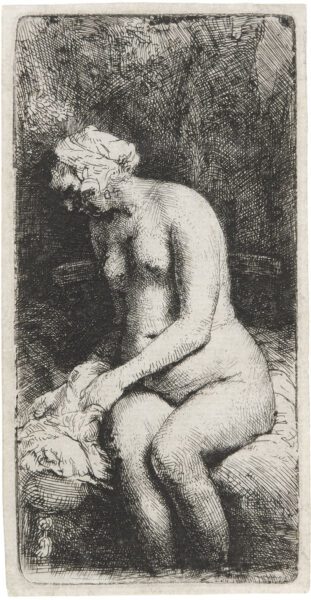“Woman bathing her feet in a brook”, 1658
Etching and drypoint: 16,0 x 8,0 cm;
signed and dated (upper left) ‘Rembrandt. | f. 1658’
"*" indicates required fields
Notes
Rembrandt made this etching in 1658, at the age of 52. Earlier, in the 1630’s Rembrandt already made a group of drawings and etchings of the female nude studied from life in the classical style. This etching, on the contrary, shows the mature style of Rembrandt: not academic but realistic. During the last decade of Rembrandt’s activity as a graphic artist, he reverted to the study of the female nude, which he had begun in the early 1630’s but had virtually abandoned by 1640. There are many drawings and six great etchings from this period of which “Woman bathing her Feet at a Brook” is one. In contrast to his early nudes, which carefully describe the sitter, these late studies concentrate on the subtle play of light and shadow over a monumental, almost classical female form. Here the master returned to the genre, concentrating on the dramatic use of light. Despite the tree-trunk and the foliage in the background, this nude has every appearance of having been done in the studio: the model is seated on a large cushion and behind her there is what looks very much like the back of a chair. The etching is without any historical or biblical context: this etching is an independent study of a nude. This wasn’t commonly accepted in those days. Rembrandt often included attributes to identify biblical or mythological subjects but they still remained clearly studies of the nude. He used this theme for his Andromeda, Susanna and the Elders, Diana and her Nymphs, Danaë and Bathseba.
Around this time, Rembrandt’s house at the Sint Anthonisbreestraat had been sold at auction and it is questionable whether Rembrandt could afford a model to pose for him. That’s why it has been often suggested that Hendrickje Stoffels, Rembrandt’s partner at that time is portrayed but no evidence can be found to prove it.
Widely recognized as the greatest practitioner of the etching technique in the history of art, Rembrandt created 300 prints that constitute a body of work unparalleled in richness and beauty. During his lifetime, Rembrandt’s extraordinary skills as a printmaker were the main source of his international fame. Unlike his oil paintings, prints travelled light and were relatively cheap. For this reason, they soon became very popular with collectors not only within, but also beyond the borders of the Netherlands.
Literature
Bartsch 200; Hind 298;
The New Hollstein Dutch no. 309, First state (of II)
Plate in existence at the Biblothèque Nationale de France, Paris
with Nowell-Usticke (1967): C1
Provenance:
– Private collection, The Netherlands.

